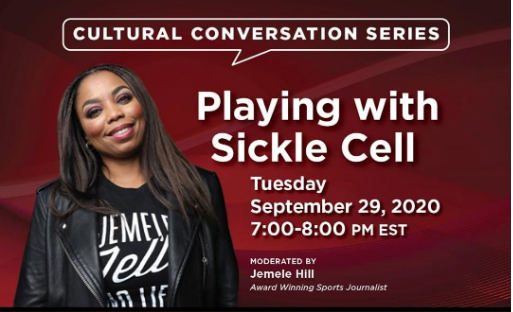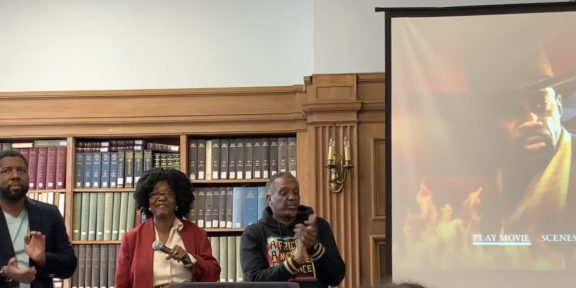By Arthur Cribbs, Howard University News Service
In honor of September being National Sickle Cell Awareness Month, Black Women’s Health Imperative hosted its cultural conversation series, “Playing with Sickle Cell,” moderated by sports journalist Jemele Hill. The event featured a medical professional as well as notable former and current NFL players like Santonio Holmes and Ty Montgomery, who dealt with sickle cell during their playing careers.
Sickle cell anemia, which affects approximately 100,000 Americans, according to the Center for Disease Control and Prevention, is especially prevalent among African Americans. About one in 13 African American babies are born with the sickle cell trait.
The President and CEO of Black Women’s Health Imperative, Linda Goler Blount, opened the event and shared her reasoning for inviting NFL players as panelists.
“The elite athletes are living proof that sickle cell is not undefeated,” Blount said. “For parents of children and adolescents who aspire to play sports while they battle the disease, we felt these stories deserved attention.”
Following that, moderator Jemele Hill added, “For African Americans, when it comes to virtually everything, we are disproportionately impacted. Not just in hereditary diseases and other ailments, but also in the type of care that we receive. Hearing from these athletes can bring inspiration and guidance.”
Opening up about sickle cell, former NFL player and current ESPN analyst Ryan Clark shared the experience he had playing in Denver, where the high altitude made him more susceptible to the disease. “The overexertion caused my blood to sickle. It was difficult for medical professionals in sports to figure out what was wrong with me. It was a very uncommon thing.”
Despite his need for medical attention, Clark also acknowledged that his symptoms are not as prevalent as many others and shared the experiences of his sister-in-law, who spent time in and out of hospitals before her death from sickle cell at the age of 27.
Ty Montgomery, who plays running back for the New Orleans Saints, also opened up about his experience as a carrier of the sickle cell trait while playing in the NFL. He did not find out that he carried the sickle cell trait until he was tested while a student-athlete at Stanford University, and, as a player at the professional level, he acknowledged the extra attention he has to play to his body.
“I have to do more than the average athlete to make sure my body has the oxygen that it needs and that my body is in shape,” said Montgomery. “I remember growing up, I cramped a lot faster than everybody else; I got hospitalized two or three times with full-body cramps and it didn’t matter how much Pedialyte or water I drank.”
Being a high-risk player during the COVID-19 pandemic, he considered sitting out the 2020 NFL season, fearing that the onset of contracting the virus could negatively impact his career.
“I was nervous that if I were to test positive, I could potentially have symptoms that would affect my career longlasting,” said Montgomery. “I decided to continue to play. If I’m not playing, I don’t have that platform.”
Former NFL player Santonio Holmes also shared his connection to sickle cell, recalling that he found out that he was a carrier of the trait as an adult and emphasized the lack of education and seriousness about the disease.
“I found out that I had a lot of family members who had it but no one ever spoke about it because it was like a ‘foreign disease’ that you don’t want to have as a little kid. I can remember a young kid I went to school with, and his eyes would become yellow from having jaundice and we would look at him like there was something wrong with him, and not knowing that I carry the sickle cell trait,” said Holmes. “Not being aware of the complications that it causes for individuals but here we are making fun of people who are living with this condition.”
Looking to spread awareness and care for people and families with sickle cell, Holmes formed the III & Long Foundation, which provides financial support and treatment options.
After personal testimonies from the professional athletes, Dr. Kim Smith-Whitley, the Director of the Comprehensive Sickle Cell Center at Children’s Hospital of Philadelphia, joined the virtual event to share the importance of testing for the trait and dispelling the stigma associated with sickle cell. She reiterated facts about the disease, such as the fact that it is inherited at birth and not contagious. She also shared that about 300 million people worldwide live with the sickle cell trait.
The only cure for sickle cell is to have a bone marrow transplant from a sibling who is a blood match and who does not carry the trait, and, as a result, cures are rare. “Until we have that cure, we have to keep those living with sickle cell healthy.”
Closing out the event, Blount shared the topics of justice, or lack thereof, surrounding those affected by sickle cell, especially in medical settings, such as hospitals.
“Black patients who show up, complaining about pain are not to be dismissed. They are to be treated, valued, respected and cared for so that they can live the life that we all want to live.”








